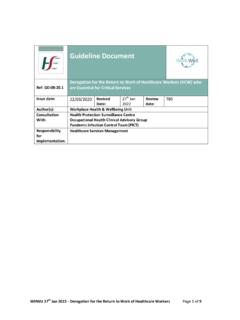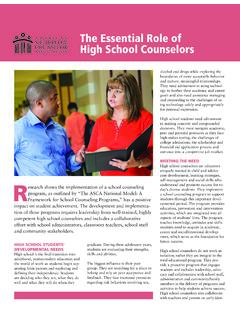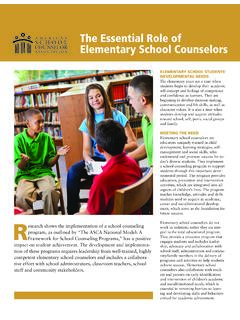Transcription of Cleaning and Disinfection Strategies for Non-Critical ...
1 1 Cleaning and Disinfection Strategies for Non-Critical Surfaces and EquipmentPresenterDan Bennett, CHESP, M-CHEST, T-CHESTM anager, Environmental ServicesSt. Joseph s Hospital-NorthContributions byDavid P. Calfee, MD, MSWeill Cornell Medical CollegeRuth Carrico, PhD, FSHEA, RN, CICU niversity of Louisville School of MedicineAssociation for the Health Care Environment2 Learning ObjectivesOutline activities that constitute appropriate Cleaning and Disinfection in healthcare settingsExplain special circumstances that may require heightened Disinfection Describe components of an effective competency-based training program for environmental services staffDiscuss auditing Strategies to measure effectiveness of Cleaning practices3 Role of Environmental Services in Infection PreventionImprovement in Cleaning and Disinfection practices can prevent pathogen transmissionEnvironmental services team plays a central role in low-and intermediate-level disinfectionCleaning and Disinfection is a critical component of any infection prevention program4 Daily Cleaning and DisinfectionPer your facility s policy.
2 Follow the manufacturer label s instruction for proper Disinfection product use5(Practice Guidance for Healthcare Environmental Cleaning , 2nd Edition, AHA, 2012; RutalaWA, CDC, 2008)Daily Cleaning and Disinfection Follow label s instruction for proper Disinfection product useClean and Disinfect all surfaces. This includes horizontal, vertical and contact surfaces Disinfect all high-touch surfaces daily and upon discharge6(Practice Guidance for Healthcare Environmental Cleaning , 2nd Edition, AHA, 2012; RutalaWA, CDC, 2008) Cleaned surfaces should remainwet and air dry per the label sinstruction Clean floors on a regular basis,when spills occur and whenvisibly soiledDaily Cleaning and Disinfection Plan a logical Cleaning pattern to be followed that accounts for room variationRestroom should always be cleaned last Follow guidelines for an optimal Cleaning path For example: clockwise, top to bottom Cleanest to dirtiest Change Cleaning cloths frequentlyClean walls, blinds and window curtains when they are visibly contaminated or soiled Change microfiber mop after each room, after isolation room and after Cleaning blood and bodily fluid spills 7(Practice Guidance for Healthcare Environmental Cleaning , 2nd Edition, AHA, 2012.)
3 RutalaWA, CDC, 2008)Special Isolation ProceduresLow- or intermediate-level disinfectants are specific to the type of isolation Consider potential contamination of privacy curtains Do not bring equipment carts into isolation roomsOnly leave the room when Cleaning is completedRemove PPEbefore leaving the patient environmentImmediately perform hand hygieneDisinfect Cleaning equipment and return to the cart8(Practice Guidance for Healthcare Environmental Cleaning , 2nd Edition, AHA, 2012; TrillisF, Infect Control HospEpidemiol, 2008; RutalaWA, Am J Infect Control, 2014) Use of No-Touch Method TechnologyUltraviolet light (UV) Reliable biocidal activity against a wide range of healthcare-associated pathogens Residual-free Useful for Disinfection room surfaces and equipment9(RutalaWA, Am J Infect Control, 2014)Hydrogen peroxide Reliable biocidal activity against a wide range of healthcare-associated pathogens Residual-free Aeration unit converts hydrogen peroxide into oxygen and water Useful for Disinfection complex equipment and furnitureBoth may pose occupational safety concerns if not used Cleaning Sheets and ChecklistsEnsures all room surfaces are cleaned and disinfected dailyEnsures all areas of the hospital are cleaned daily10 Responsibility of Equipment Cleaning Collaborative effort to determine responsibility for Cleaning of Non-Critical equipment Staff should be trained on who is responsible for Cleaning equipment and how and when Cleaning should occur Non-Critical Equipment.
4 Infusion pumps Sequential compression device pumps Glucometers Blood pressure monitors Mobile computers and workstations Tablets or smartphone Ventilators11 Non-Critical EquipmentUse dedicated disposable devices when availableIf a dedicated, disposable device is not available, disinfect all Non-Critical patient care equipment before removing the device from the room and before using it with another patientDisinfect Non-Critical medical devices with a n EPA-registered hospital disinfectant following the label s instructions12(RutalaWA, CDC, 2008) Assure staff responsible for device Cleaning receive training on Cleaning procedures that follow the equipment manufacturer s instructions Competency-Based Training for Environmental Services New Hire Competency AssessmentsTraining and RetrainingClassroom training,with written quizzesConduct trainings and administer written exams at monthly meetingPreceptor trainingDeliver trainings for team members that fail auditsObservation of PPE donningand doffingNew policyimplementationObservation of daily cleaningReview necessary Cleaning procedures at daily huddlesObservation of discharge cleaningReview competencies tested during new hire training annuallyObservation of C.
5 Difficileisolation discharge 13 Maintaining Competency through Annual AssessmentsAnnual Competency Checks Successful attendance at monthly training and pass written exams Pass PPE donning and doffing observed by management Pass three observed cleanings by management Daily Cleaning Discharge Cleaning C. difficile discharge Isolation cleaningCertification for Healthcare Environmental Services Technician, CHEST Offered by Association for Healthcare Environment (AHE) Frontline staff certification Complete required training Pass certification exam14 Auditing the Effectiveness of CleaningVisual assessment: is not a reliable indicator of surface cleanlinessDirect observation: measures individuals adherence to processesFluorescent marker: determines if a particular area was wiped AT P bioluminescence: measures actively growing microorganisms through detection of adenosine triphosphate (ATP) Each unit has own reading scale, <250-500 RLU 15(Cooper RA, Am J Infect Control, 2007)What to Test16(GuhA, CDC, 2010)Available at.
6 Best practices for environmental disinfectionProperly train and educate environmental service technicians on proper Cleaning and Disinfection processesHave nursing, respiratory therapists, infection preventionistsand environmental services agree upon a list of equipment that are to be cleaned and disinfected by Nursing and by Environmental ServicesAudit Cleaning and Disinfection practices and provide feedback to environmental services technicians to ensure proper Disinfection of surfaces17 ReferencesCooper RA, Griffith CJ, Malik RE, et the effectiveness of Cleaning in four British J Infect Control. 2007; 35(5): 338 , Carling P, Environmental Evaluation for evaluating environmental for Disease Control and Prevention. 2010. Available at: Accessed on September 23, guidance for healthcare environmental Cleaning , second edition. Association for Healthcare Environment. Chicago: American Hospital Association, 2012.
7 RutalaWA, GergenM F, Sickbert-Bennett EE, et al. Effectiveness of improved hydrogen peroxide in decontaminating privacy curtains contaminated with multidrug-resistant J Infect Control. 2014; 42(4): 426 , Weber used for environmental Disinfection and new room decontamination J Infect Control. 2013; 41(5 Suppl): , Weber DJ, Healthcare Infection Control Practices Advisory Committee. Guideline for Disinfection and sterilization in healthcare facilities, 2008. Centers for Disease Control and Prevention. 2008. Available at TrillisF 3rd, Eckstein EC, BudavichR, et al. Contamination of hospital curtains with healthcare-associated Control HospEpidemiol. 2008;29(110): 1074 NotesSpeaker Notes: Slide 1 Hello, and welcome to the second module Environmental Cleaning course. This module, entitled Cleaning and Disinfection Strategies for Non-Critical Surfaces and Equipment, will provide an overview of Strategies to consider when training environmental services technicians about Cleaning and Disinfection policies and procedures, and to identify tools to assist with monitoring and auditing practices.
8 20 Speaker Notes: Slide 2 This module was developed by national infection prevention experts devoted to improving patient safety and infection prevention efforts. 21 Speaker Notes: Slide 3 After completing this module you will be able to: Outline activities that constitute appropriate Cleaning and Disinfection in healthcare settings; Explain special circumstances that may require heightened Disinfection ; Describe components of an effective competency-based training program for environmental services staff; and Discuss auditing Strategies to measure effectiveness of Cleaning Notes: Slide 4As we discussed in module one, Cleaning and Disinfection of the patient care environment is an important aspect of preventing transmission of microbes that can lead to patient and staff harm. The environmental services team plays an essential role in ensuring that low-level and intermediate Disinfection is performed properly.
9 For this module we will focus on recommended Cleaning and Disinfection processes that, when performed by environmental services technicians, provides a critical component of any infection prevention program. 23 Speaker Notes: Slide 5To begin, let s discuss daily practices that should be followed for Cleaning and Disinfection . Cleaning and Disinfection , as a one-step process, use a disinfectant detergent that doesn t require pre- Cleaning of surfaces unless grossly contaminated or if a spill occurred. You should recall from the first module on environmental Cleaning and Disinfection that there are different levels of disinfectants. Low level Disinfection kills most vegetative bacteria, some viruses, and some fungi, but cannot be relied upon to kill mycobacteria or bacterial spores. 24 Speaker Notes: Slide 5 ContinuedIntermediate level Disinfection kills vegetative bacteria, most viruses and most fungi, but does not reliably kill bacterial spores.
10 High level Disinfection , often referred to as HLD, completely eliminates all microorganisms except for small numbers of bacterial spores. The environmental services technician should select the level of disinfectant required per their hospital s policy. All disinfectants should be used according to the manufacturer s label Notes: Slide 6 Manufacturer s label instructions indicated dilution, contact time (the time it should remain wet), surface compatibility and other safe use instructions. For both daily Cleaning and discharge Cleaning , all surfaces should be cleaned and disinfected with a damp wiped with a microfiber or disposable cloth saturated with the disinfectant-detergent solution. The diagram on the slide highlights common high-touch surfaces the environmental services technician should pay special attention to, focusing on these areas and the surfaces that are in the immediate vicinity of the patient.















